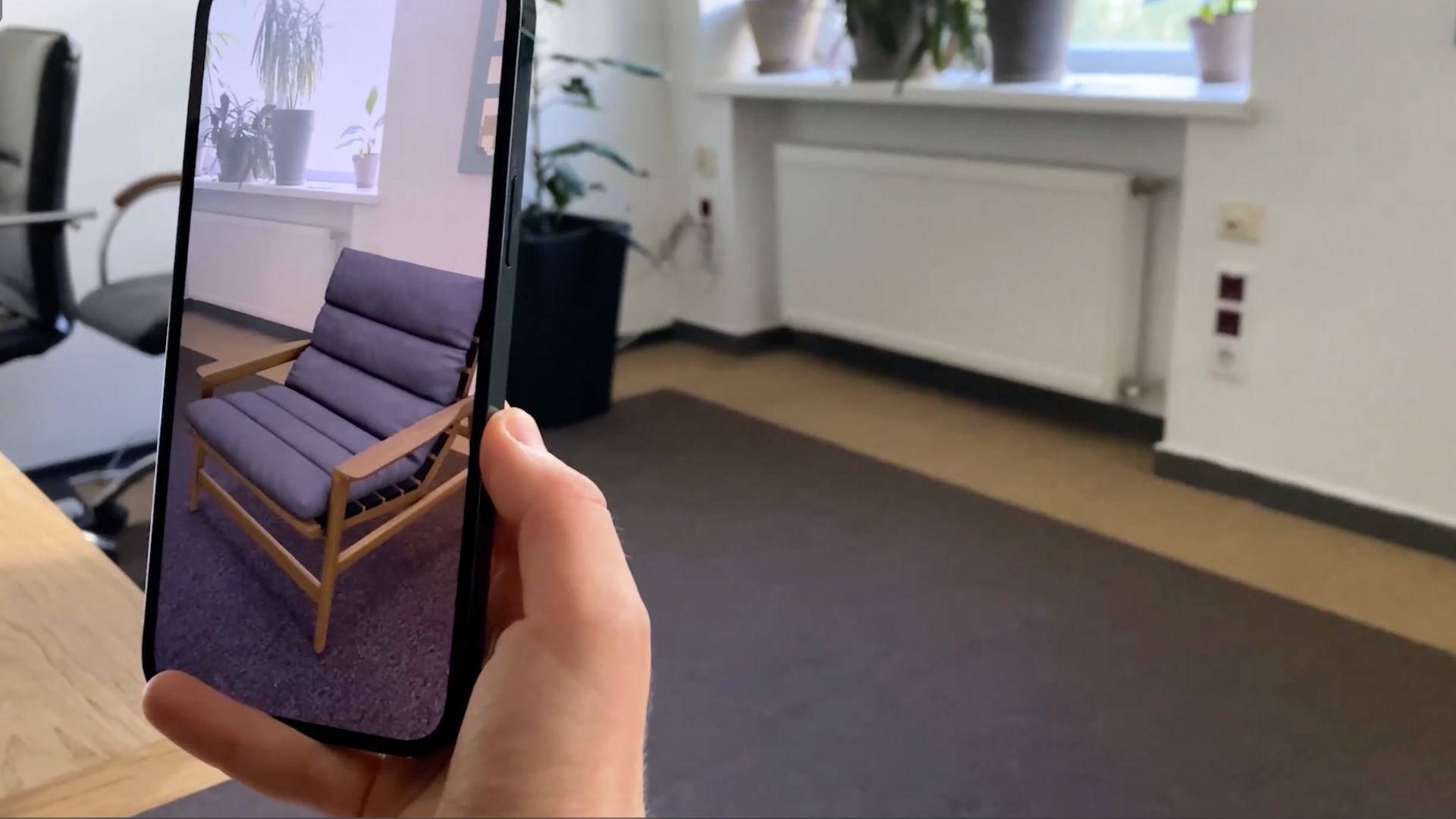Augmented reality (AR) has transformed the way furniture brands market their products to consumers. By mixing real-world images with computer graphics, AR creates a new dimension in which customers can interact with virtual versions of products such as sofas and armchairs.
In this article, our 3D rendering company will explore the potential benefits and drawbacks of using Augmented Reality in content marketing for your furniture brand.
Keep reading!
#1. What is Augmented Reality in Furniture Content Marketing?
AR is a technology that allows customers to visualize furniture pieces in their own space, virtually placing them in real-time. By using a smartphone or tablet with AR capabilities, customers can see how furniture fits into their environment, adjust dimensions, and customize finishes.
Augmented Reality in content marketing lets customers experience an item in the real world, leading to better buying decisions. It also provides a unique way to showcase furniture products and differentiate brands from competitors.
If you are interested in learning about how AR models are created, we recommend reading AR 3D Models: How CG Artists Make 3D Models for AR Apps. This article is a great resource for furniture brands looking to incorporate AR into their content marketing strategy.
#2. Pros of Augmented Reality in Furniture Content Marketing
Augmented Reality offers a range of benefits for furniture content marketing. By incorporating AR experiences into marketing campaigns, furniture brands can enhance the customer experience, reduce product returns, increase engagement and brand differentiation, facilitate personalization and customization, and even generate social media virality.
In this section, we will explore each of these advantages in more detail, helping you understand why Augmented Reality in content marketing is becoming an increasingly popular tool in the furniture industry.
2.1. Enhanced Customer Experience
One of the major benefits of incorporating Augmented Reality into furniture content marketing is the enhanced customer experience it provides. With AR, customers can see how furniture pieces would look in their own space, in real-time, before making a purchase. This not only helps customers make more informed decisions, but it also increases their confidence and satisfaction with their purchase.
The ability to virtually place furniture in a customer’s actual space also provides a more realistic representation of the product, making it easier for customers to visualize how it will fit into their home decor. This immersive experience can lead to a stronger emotional connection between the customer and the product, ultimately increasing the likelihood of a purchase.
2.2. Reduced Product Returns
Another advantage of incorporating Augmented Reality in content marketing is the potential to reduce product returns. With AR, customers can see how furniture pieces will look in their own space, allowing them to better judge size, color, and style before making a purchase. This reduces the likelihood of misjudging these factors and subsequently returning the product.
By reducing product returns, furniture brands can improve customer retention rates, save costs for both customers and retailers, and ultimately increase profitability. Additionally, by reducing the environmental impact of product returns, furniture brands can also improve their sustainability efforts, which is becoming increasingly important to customers.
Overall, AR can help furniture brands improve the efficiency and sustainability of their operations while also enhancing the customer experience.
2.3. Increased Engagement and Brand Differentiation
Incorporating Augmented Reality content marketing into furniture e-commerce and brand strategy can also lead to increased engagement and brand differentiation. AR offers a unique and interactive way to showcase furniture products, allowing customers to virtually place furniture in their own space and customize it to their liking.
By offering this immersive experience, furniture brands can captivate and engage customers, leaving a lasting impression and differentiating themselves from competitors. This can lead to increased brand awareness and customer loyalty, as customers are more likely to remember and recommend brands that offer unique and memorable experiences.
Additionally, by incorporating AR into marketing campaigns, furniture brands can create a buzz on social media platforms, generating organic promotion and expanding their reach. AR can help furniture brands stand out in a crowded market and create a lasting impression on customers.
2.4. Personalization and Customization
Another benefit of incorporating Augmented Reality in content marketing is the ability to facilitate personalization and customization. With AR, customers can customize furniture pieces virtually, selecting fabrics, finishes, and adjusting dimensions to create their ideal product. This immersive experience fosters a sense of ownership and connection between the customer and the product, increasing the likelihood of a purchase and improving customer satisfaction.
By offering personalized experiences, furniture brands can also stand out from competitors and create a stronger emotional connection with customers. Besides, by using AR to facilitate customization, furniture brands can streamline the production process and reduce waste by only producing products that customers have already customized and shown interest in. This can lead to cost savings and improved sustainability efforts.
Overall, AR can help furniture brands offer personalized experiences that cater to individual customer needs and preferences, improving customer satisfaction and loyalty.
2.5. Social Media Virality
Finally, incorporating Augmented Reality in content marketing can also generate social media virality. By offering unique and immersive experiences through AR, customers are more likely to share their experiences on social media, generating organic promotion for furniture brands. This can lead to increased brand awareness and customer engagement, as well as expanding the reach of marketing campaigns.
Additionally, by incorporating AR into social media marketing campaigns, furniture brands can create interactive and shareable content that stands out from traditional advertising. This can lead to increased engagement and customer loyalty, as customers are more likely to remember and recommend brands that offer unique and memorable experiences.
#3. Cons of Augmented Reality in Furniture Content Marketing
While there are many potential benefits to incorporating Augmented Reality into furniture content marketing, there are also some drawbacks to consider. In this section, we will explore some of the potential cons of using AR in furniture marketing campaigns.
3.1. Technical Limitations
One of the main drawbacks of incorporating Augmented Reality into furniture content marketing is the technical limitations. AR experiences require a strong internet connection and specific hardware, such as smartphones or tablets with AR capabilities. Customers who do not have access to these technologies may be unable to access AR experiences, limiting the potential reach of marketing campaigns.
Additionally, AR experiences may not work as well in certain lighting conditions or environments, which can impact the overall customer experience. Technical limitations can be a barrier to entry for some customers and may reduce the effectiveness of AR marketing campaigns.
3.2. Development Costs
One of the main concerns for furniture brands when considering incorporating Augmented Reality in content marketing is the cost of development. Creating high-quality AR experiences can be a significant investment, requiring skilled developers, designers, and 3D assets. This initial investment may be a barrier for smaller furniture brands or those with limited marketing budgets.
However, there is good news for furniture brands that want to take advantage of AR technology but are concerned about the development costs. CGIFurniture is a studio that specializes in creating high-quality 3D assets and AR models for furniture brands. Our team of skilled developers and designers can help create AR experiences that are tailored to your specific needs and budget.
By working with CGIFurniture, furniture brands can overcome the cost barrier and take advantage of the benefits that AR technology offers. Our studio can provide a range of AR solutions, from simple AR product viewers to more complex AR experiences that allow customers to customize and interact with furniture pieces in real-time.
3.3. Learning Curve
Another potential drawback of incorporating Augmented Reality into furniture content marketing is the learning curve. Both customers and marketers need to familiarize themselves with AR technology and its functionalities. This may slow down adoption and require additional resources for customer support and training.
By working with a professional 3D studio, furniture brands can ensure that their AR experiences are user-friendly and intuitive, minimizing the need for additional customer support and training. Additionally, a 3D modeling studio can help furniture brands create AR experiences that are tailored to their specific needs and goals, ensuring that they provide maximum value to customers.
3.4. Integration Challenges
Another potential drawback of incorporating Augmented Reality in content marketing is the integration challenges. Integrating AR into existing furniture brand channels and platforms can be complex, and it may require collaboration with software developers, website designers, and e-commerce platforms to ensure a seamless user experience across all touchpoints.
Overall, while integration challenges may be a concern for furniture brands considering AR technology, working with a professional 3D studio like CGIFurniture can help overcome this drawback and provide a range of benefits for furniture content marketing. Our team can help furniture brands create high-quality AR tools that seamlessly integrate with their existing marketing landscape, providing customers with a unique and memorable experience.
#4. How to Incorporate Augmented Reality Content Marketing
Augmented Reality (AR) has emerged as a game-changing technology for the furniture industry, allowing customers to visualize furniture products in their homes before making a purchase.
In this section, we will outline the steps that furniture brands can take to harness the power of AR and incorporate it into their content marketing strategy.
- Hire a professional 3D modeling studio to create high-quality 3D models of your furniture products.
- Use the 3D models to create an AR shopping app or integrate the AR experience into your existing e-commerce platform through APIs.
- Utilize the AR models through various marketing channels such as social media, email marketing, and digital ads to increase customer engagement and brand awareness.
- Consider offering personalized experiences through AR, such as allowing customers to customize finishes or adjust the dimensions of furniture pieces in real time.
- Ensure that the AR experience is user-friendly and intuitive, and provide customer support and training as needed.
- Continuously gather feedback from customers to improve the AR experience and tailor it to their needs and preferences.
- Stay up-to-date with the latest AR technology advancements and trends to ensure that your AR content remains relevant and innovative.
In conclusion, Augmented Reality in content marketing has significant potential to transform furniture businesses by enhancing customer experiences, reducing product returns, and increasing engagement. However, it is important to weigh the pros and cons before implementing AR into your strategy.
Consider factors such as technical limitations, development costs, learning curves, integration challenges, and user engagement to make an informed decision that aligns with your brand’s goals and resources.
In order to create high-quality AR experiences for your furniture content marketing, you may need to invest in 3D modeling services for Augmented Reality marketing. Our team of skilled developers and designers can create high-quality AR models tailored to your specific needs and budget. By working with us, you can overcome the barriers and take advantage of the benefits that AR technology offers. Contact us today to learn more!






Leave a Reply
Want to join the discussion?Feel free to contribute!